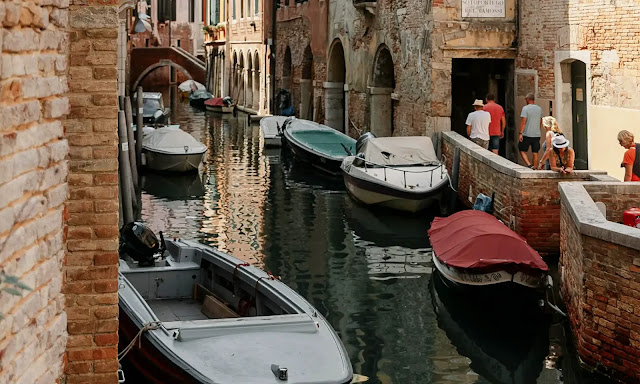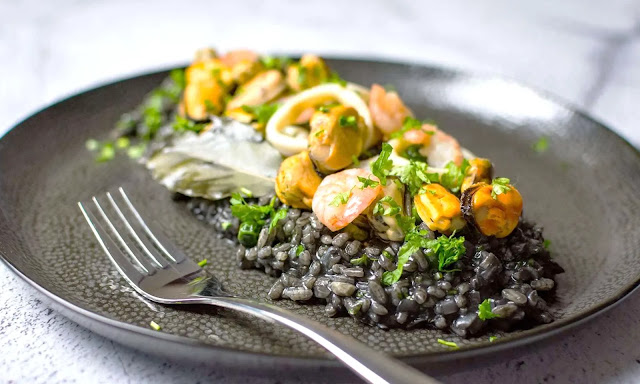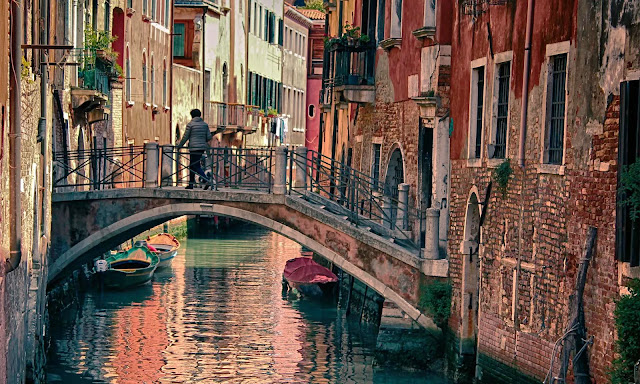Venice, the City of Water and Canals
Venice, an iconic city in Italy, is known as one of the wonders of the world due to its uniqueness as the "City of Water." Built on 118 small islands separated by canals and connected by more than 400 bridges, Venice is a perfect blend of art, history, and architecture. The city uses gondolas, vaporetto (water transport), and boats as its main modes of transportation, replacing land vehicles such as cars. With its unique design, Venice is not only a symbol of romance but also a testament to human engineering excellence that has endured since the 5th century.
In addition to its classical architecture, Venice is also home to historical sites such as the Basilica di San Marco, the Grand Canal, and the Rialto Bridge. Every corner of this city offers breathtaking views that are unmatched anywhere else. No wonder, Venice has become a popular tourist destination, visited by millions of people every year. However, the city faces serious challenges due to climate change and rising sea levels, which could potentially threaten its existence in the future. Initiatives such as the MOSE project, designed to protect Venice from flooding, demonstrate the efforts of the community to preserve this city as a world cultural heritage.
Venice, a City Born on Water
Venice was born out of the need for protection and security. In the 5th century, the people of Northern Italy fled to the lagoon area to escape attacks from barbarian tribes, such as the Visigoths and Huns, who threatened the mainland. Initially, they lived on small islands filled with marshes. However, thanks to their skill in utilizing the environment, the residents began building the city's foundation using wooden piles driven into the lagoon's bed. This foundation, though simple in appearance, became the backbone of the city's structure that endures to this day.
From the 9th to the 15th century, Venice developed into a dominant maritime power in the Mediterranean Sea. The city became a hub for international trade, especially in valuable commodities like spices, silk, and salt. The resulting wealth made Venice a city adorned with magnificent buildings, such as the Doge's Palace and the Basilica di San Marco. Moreover, Venice was known as a pioneer in the arts and culture, producing masterpieces by artists like Titian and Tintoretto. The city not only marked itself as a trading center but also as a symbol of the grandeur of European civilization.
The history of Venice is an extraordinary testament to how humans have overcome the limitations of nature to build a magnificent civilization on water. However, challenges such as rising sea levels and erosion continue to pose a threat to this historical heritage. Will the city be able to withstand the test of time? Only time will tell.
The Charm of the Grand Canal, the Main Icon of Venice
The Grand Canal, or "Canal Grande," is the heartbeat of Venice, serving as a major attraction for tourists from all over the world. This approximately 3.8-kilometer-long canal stretches like an inverted "S," dividing Venice into two parts and connecting many important districts in the city. Along the canal, stand historic buildings in Renaissance, Gothic, and Baroque styles, reflecting Venice's former glory. From majestic palaces like Palazzo Barbarigo to the iconic church of Santa Maria della Salute, every corner of the Grand Canal offers breathtaking views.
One of the best ways to experience the beauty of the Grand Canal is by taking a gondola or vaporetto, the traditional water transportation of Venice. As you glide along the canal, you can soak in the romantic atmosphere of the city while admiring the architectural beauty standing tall on both sides. Moreover, the Grand Canal is also the venue for various important events, such as the Regata Storica, a vibrant and colorful traditional boat parade.
The Grand Canal is not just a waterway; it is a symbol of Venice's irreplaceable life and culture. Every ripple in the canal seems to carry the long history of a city that has witnessed great civilizations. For anyone visiting, the Grand Canal offers an unforgettable experience, serving as a compelling reason to return to Venice time and time again.
Explore the City with a Gondola Ride – A Must-Try Experience
Sailing in a gondola in Venice is an iconic experience that should not be missed. The gondola is not just a means of transportation, but also a symbol of the romance and history of this city. With its sleek shape and classic ornaments, the gondola has been an integral part of Venetian life since the 11th century. The gondoliers, dressed in their traditional uniforms, not only navigate the boats with exceptional skill but often share fascinating stories about the city's history and culture during the ride.
A gondola ride takes tourists through small canals that cannot be reached by other water transportation. You will pass narrow water alleys surrounded by old buildings, charming stone bridges, and unique views that showcase the everyday life of the locals. One of the most popular routes is through the Grand Canal, with a brief stop under the Rialto Bridge—an ideal spot to enjoy the view and capture iconic photos.
Although often considered a tourist activity, riding a gondola remains an authentic way to experience the true atmosphere of Venice. Accompanied by music from the gondoliers or just the calm sound of rippling water, this journey creates a magical moment that is hard to forget. So, if you're in Venice, be sure to enjoy the city from a gondola—this experience truly lives up to expectations.
Piazza San Marco
Piazza San Marco, or St. Mark's Square, is the heart of life and culture in Venice, always bustling with activity. This square has become one of the most iconic places in the world, surrounded by magnificent historic buildings like the Basilica di San Marco, St. Mark's Bell Tower (Campanile), and the Doge's Palace. With its lively atmosphere, Piazza San Marco is often referred to as the living room of Venice, as it serves as a gathering place for locals, tourists, and street performers who bring the area to life.
The majestic Basilica di San Marco is the main attraction of the square. With its Byzantine-style architecture and golden mosaics adorning its interior, the basilica is a symbol of Venice's past wealth and glory. On the other side, St. Mark's Bell Tower offers breathtaking views of the city of Venice from above. For those wanting to experience the authentic Venetian atmosphere, enjoying a cup of coffee at one of the historic cafes like Caffè Florian while watching the hustle and bustle of Piazza is an invaluable experience.
However, Piazza San Marco also faces significant challenges due to frequent tidal floods (acqua alta), especially during the fall and winter months. Despite this, the city government continues to work hard to preserve the square as a world cultural heritage that remains captivating. Piazza San Marco is not just a place, but the center of the stories and soul of Venice, timeless and enduring.
Venetian Cuisine
Venice not only captivates with its stunning architecture and canals but also offers a rich culinary tradition, especially with its strong maritime influences. As a port city, seafood-based dishes take center stage. One of the most famous is sarde in saor, sardines cooked with onions, vinegar, raisins, and pine nuts. This dish not only offers a unique sweet-and-sour flavor but also has a long history as a meal for Venetian sailors.
Additionally, you must try risotto al nero di seppia, a risotto cooked with cuttlefish ink, resulting in a savory taste and a distinctive deep black color. This dish is often served in local restaurants with a modern twist. Don't miss bigoli in salsa, a traditional Venetian pasta made with anchovy sauce and onions—simple yet delicious. For a snack, try cicchetti, small dishes similar to tapas, often enjoyed with a glass of wine at local bars, also known as bacari.
To top it off, be sure to try bussolai buranelli, a ring-shaped biscuit from the island of Burano. With its strong vanilla aroma and crisp texture, this cookie has become a favorite among both tourists and locals. Venetian cuisine is not only about flavor but also about how the city preserves its culinary traditions, influenced by its history and maritime culture. Tasting the local dishes is as authentic an experience as sailing on a gondola.
The Islands of Murano and Burano
The island of Murano is a must-visit destination for glass art enthusiasts. Located just a few minutes from the center of Venice, Murano has been known as a hub for artistic glass production since the 13th century. Here, you can witness firsthand the process of making Murano glass, famous worldwide. Skilled artisans, with their inherited techniques, blend quartz sand and high temperatures to create stunning works of art such as vases, sculptures, and lamps. The Glass Museum (Museo del Vetro) in Murano also provides an in-depth look at the history and evolution of glass art from ancient times to the modern day.
Meanwhile, the island of Burano offers a different charm with its brightly colored houses. This small island is known as one of the most photogenic places in Italy. The vibrant colors of the houses in Burano were not only for visual appeal but also served a practical purpose in the past: helping fishermen find their way home during foggy conditions. Additionally, Burano is famous for its lace-making (merletto), a tradition that has been passed down for centuries. Visitors can stop by the Lace Museum (Museo del Merletto) to learn more about this intricate craft.
Visiting Murano and Burano is the perfect way to complement your experience in Venice. These islands not only offer visual beauty but also introduce you to the rich local traditions and culture that have endured for centuries. With their tranquil atmosphere and captivating views, Murano and Burano are the ideal escape from the hustle and bustle of central Venice.
Tips for Traveling to Venice, Italy
Venice is one of the most unique destinations in the world, but a trip to this city requires careful preparation to make your experience more enjoyable. First and foremost, avoid visiting during peak seasons like summer, as the city can become very crowded with tourists. The best time to visit Venice is during the off-season, such as in the fall or early spring, when the weather is still pleasant and the crowds are more manageable. Additionally, be sure to wear comfortable shoes, as many of Venice's streets are made of stone, and you will be walking a lot, whether along the canals or to historical sites.
While in Venice, don't miss the opportunity to explore the city by gondola, although the cost of a gondola ride can be quite expensive. Alternatively, you can choose to take a vaporetto, a more affordable water public transportation, to enjoy views of the Grand Canal from various angles. To experience Venice more locally, try visiting traditional markets like the Rialto Market and sampling local dishes such as cicchetti or sarde in saor. Don't forget to bring your camera, as every corner of the city, from bridges to ancient churches, is incredibly photogenic.
Lastly, prepare yourself for the challenge of high tide (acqua alta) if you are visiting during the fall or winter. Some areas in Venice can become flooded, so bring waterproof shoes or be ready with plastic boots, which are often provided by local stores. With a little preparation, your trip to Venice can be an unforgettable experience, full of beauty and uniqueness that can only be found in this city of water.








